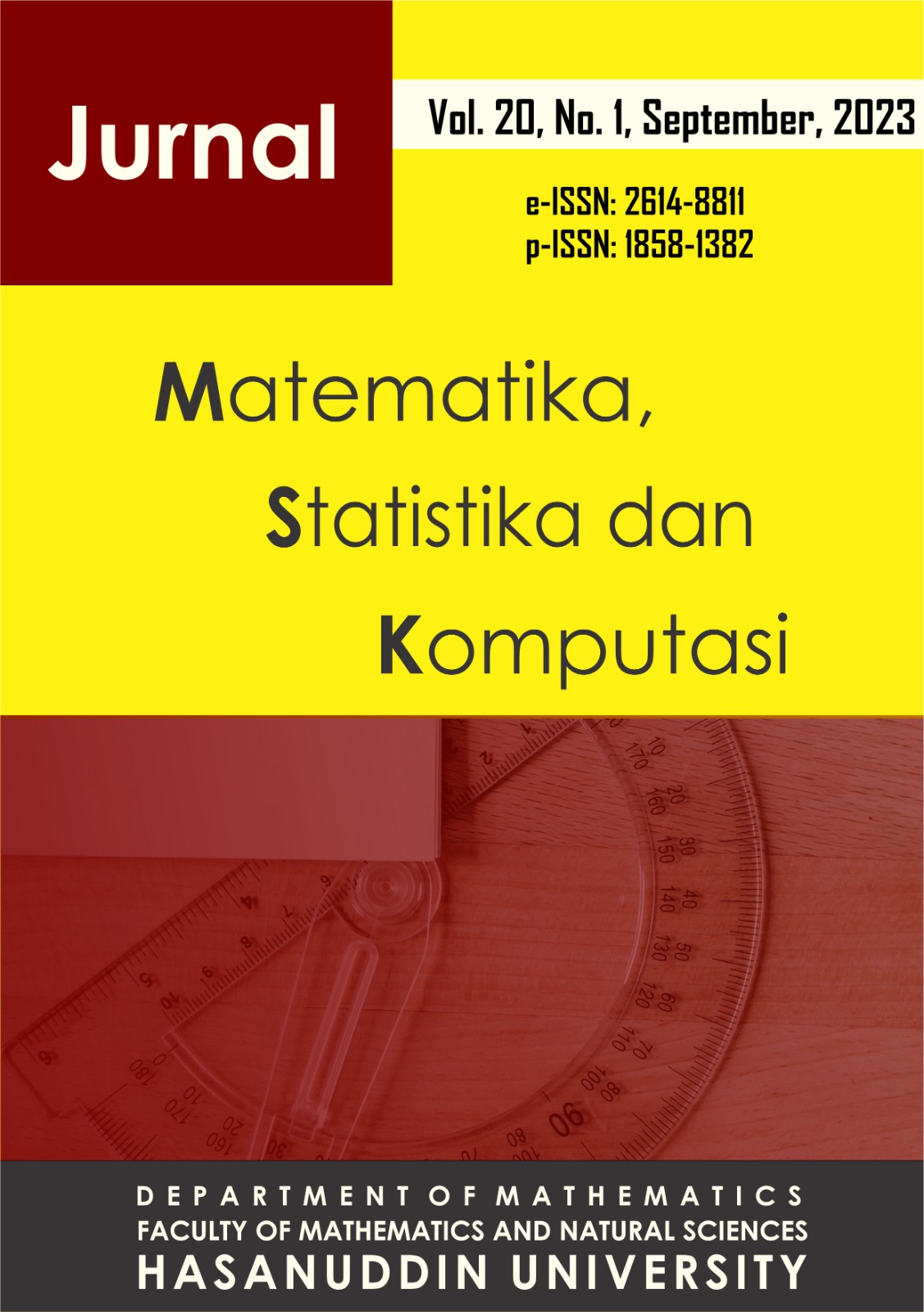Stability Analysis and Numerical Simulation of the COVID-19 SISiR Model
Bahasa Indonesia
DOI:
https://doi.org/10.20956/j.v20i1.27747Keywords:
COVID-19, model SISiR, lockdown, analisis kestabilanAbstract
This research discusses the SISiR model (Susceptible Infected Sick Recovered) considering individual immune parameters and lockdown parameters. The consideration of these parameters aims to determine whether immunity and lockdown have an impact on the spread of COVID-19. The model's stability is analyzed around the equilibrium point to understand the dynamics of COVID-19 spread in a population. Furthermore, the parameter R0 is determined to indicate whether COVID-19 disappears or remains in the population. From numerical simulations with spesific parameter values, it is concluded that COVID-19 continues to spread in the population with an R0 = of 4.4486. The addition and reduction of immune and lockdown parameters affect the spread of COVID-19.Downloads
References
Anna, A.S., 2020. Penentuan Rumus Bilangan Reproduksi Dasar pada Model Matematika COVID-19 dari Model SIR yang Dimodifikasi. EduMatSain, Vol. 5, No. 2, 203-210.
Bastistela, C.M., Correa, D.P.F., Bueno, A.M. & Piqueira, J.R.C., 2021. SIRSi Compartmental Model for COVID-19 Pandemic with Immunity Loss. Chose, Solitons and Fractals Journal, Vol. 142, No. 110388, 1-12.
Brauer, F. & Carloz-Chavez, C., 2010. Mathematical Models in Population Biology and Epidemiologi Second Edition, New York : Spinger Vancouver B. C.
Driessche, P., Van D. & Watmough, J., 2002. Reproduction Numbers and Sub-threshold Endemic Equilibria for Compartmental Models of Diasease Transmission. Mathematical Biosciences, Vol. 180, No. 1-2, 29-48.
Giordano, F.R., Fox, W.P. & Horton, S.B., 2013. A First Course in Mathematical Modeling Fifth Edition. Cengage Learning, Boston.
Putri, R.N., 2020. Indonesia Dalam Menghadapi Pendemi COVID-19. Jurnal Ilmiah Universitas Batanghari Jambi, Vol. 20, No. 2, 705-709.
Rifanti, U.M., Dewi, A.R., Nurlaili & Hapsari, S.T., 2021. COVID-19 Mathematical Epidemic Model for Impacy Analysis of Large Scale Social Restriction: The Case Study of Indonesia. IOP Conf. Series Materials Science and Engineering, Vol. 1115.
Mishra, B.K., Keshri, A.K, Rao, Y.S., Mahato, B. & Ayesha S., 2020. COVID-19 Created Chaos Across the Globe: Three Novel Quarantine Epidemic Models. Chaos Solitons Fractals, Vol. 138.
Li, R., Pei, S., Chen, B., Song, Y., Zhang, T., Yang, W. & Shaman J., 2020. Substantial Undocumented Infection Facilitates the Rapid Dissemination of Novel Coronavirus (SARS-CoV2), Science, Vol. 368, No. 6490, 489–93.
Jajarmi, A., Yusuf, A., Baleanu, D. & Inc, M.A., 2020. New Fractional HRSV Model and ts Optimal Control: a Non-Singular Operator Approach. Physica A, Vol. 547.
Godio, A., Pace, F. & Vergnano, A., 2020. SEIR Modeling of the Italian Epidemic of SARS- CoV-2 Using Computational Swarm Intelligence. Int Environ Res Public Health, Vol. 17.
Downloads
Published
How to Cite
Issue
Section
License
Copyright (c) 2023 Author and publisher

This work is licensed under a Creative Commons Attribution 4.0 International License.

This work is licensed under a Creative Commons Attribution 4.0 International License.
Jurnal Matematika, Statistika dan Komputasi is an Open Access journal, all articles are distributed under the terms of the Creative Commons Attribution License, allowing third parties to copy and redistribute the material in any medium or format, transform, and build upon the material, provided the original work is properly cited and states its license. This license allows authors and readers to use all articles, data sets, graphics and appendices in data mining applications, search engines, web sites, blogs and other platforms by providing appropriate reference.








